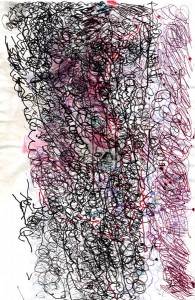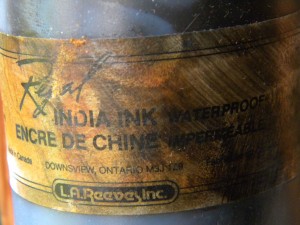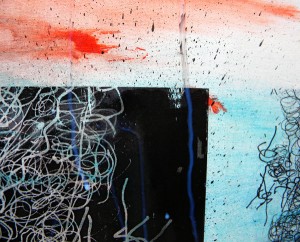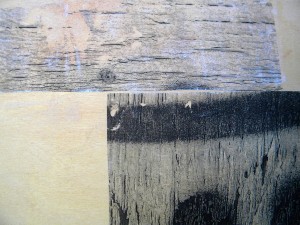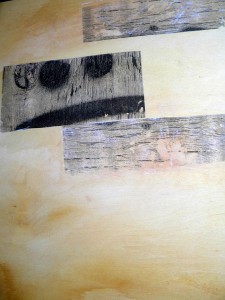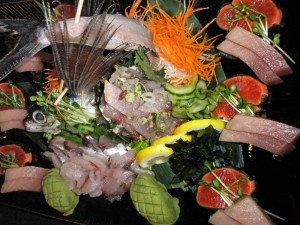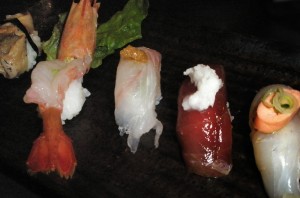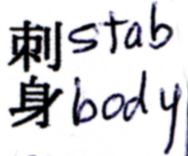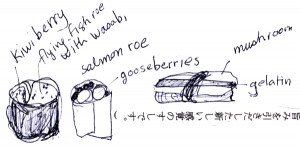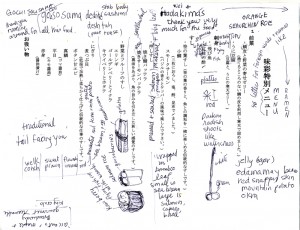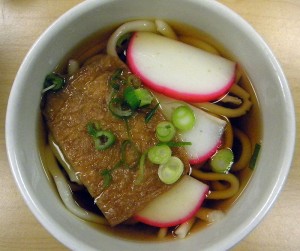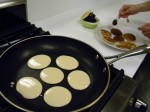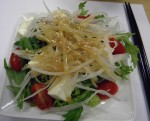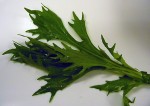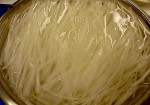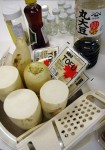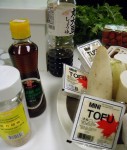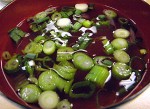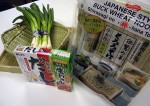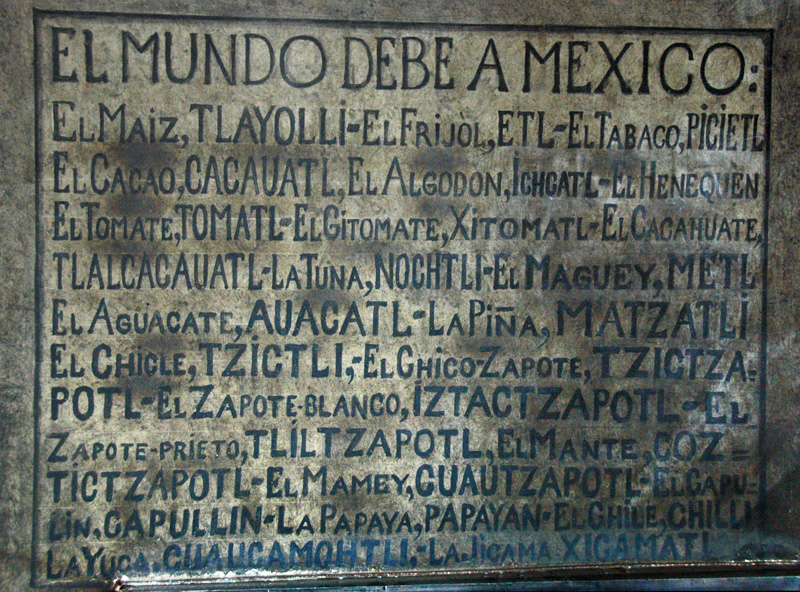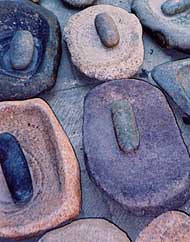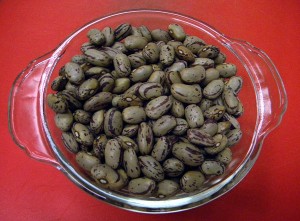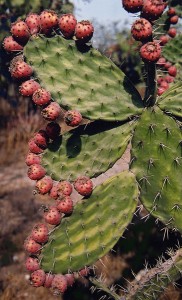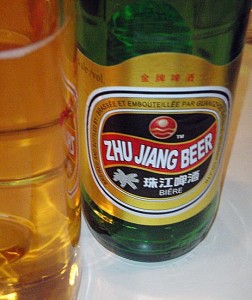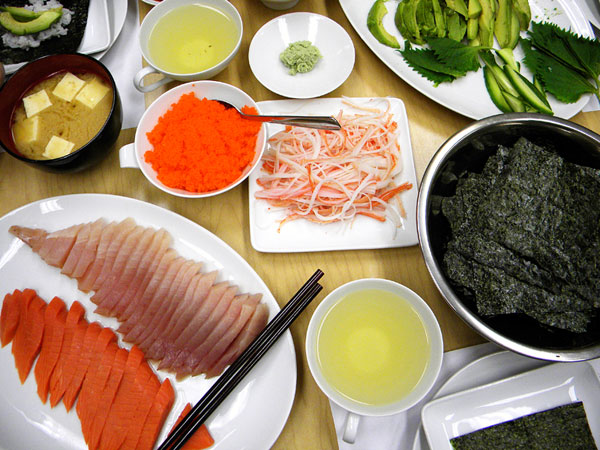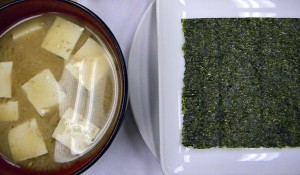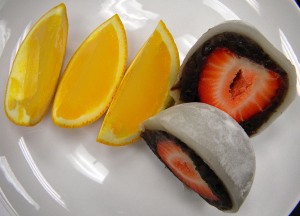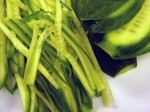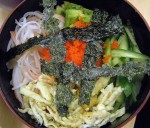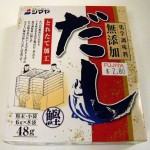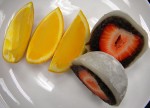This class contained introductions to even more Japanese ingredients that I had never heard of. We started with miso soup with little beech mushrooms, and then began prepping the salads and the main course of mackerel, nimono and rice.
Polished white rice (uruchi mai), the most common rice in Japan, was the side dish. It must be rinsed several times with a scrubbing motion to ‘polish’ it and remove the excess starch. The rinse water will be milky white for the first few rinses but will eventually become clear. Add 1 1/4 cup water to 1 cup rice in a pot with a tight-fitting lid, and cook for about 30 minutes, resulting in a fairly ‘sticky’ rice.
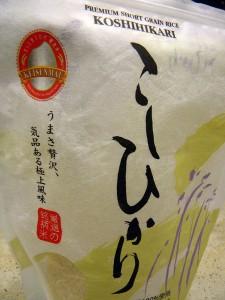
beautiful Japanese packaging of polished white rice (uruchi mai). This is the most common rice used in Japan, and is used both as a side dish and for sushi.
Gomaae: sesame-dressed salad. Spinach is commonly used for gomaae in North America, but in Japan everything from greens to fish and meats are used. For our gomaae Hana chose asparagus, chopped into 1 1/2 inch pieces and boiled for 3 minutes, together with cherry tomatoes cut in half. The dressing has several variations but all versions contain ground sesame seeds, sugar and soy sauce. Sometimes sesame oil is added although not always. I love sesame seeds so I really liked this salad. Hana’s recipe for gomaae (sesame seed dressing) on her blog: http://letsforking.wordpress.com/2010/10/24/spinach-gomaae/
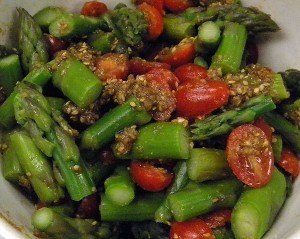
Japanese sesame-dressed salad aka ‘gomaae’
The other salad, ‘onion and jako’, was… interesting. It reminded me of the first time I tried seaweed. Then I wasn’t so sure about it, but now I go out of my way to get seaweed-wrapped treats. The first step to making the salad is to soak paper thin slices of white onion to reduce any onion flavour, similar to the daikon radish prep in the previous class. I actually like the pungent flavours of both white onions and daikon, and am not really sure I like these wishy-washy versions. I suppose they had to be made more delicate in order to taste the jako that was tossed in with them. Jako are baby sardines, teeny tiny little translucent things.
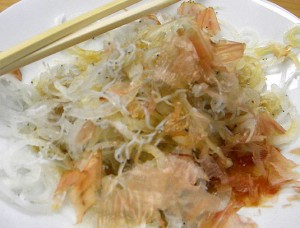
onion & jako salad
The salad was drizzled with Ponzu and pinkish bonito fish flakes were piled on top giving the dish faintly fishy taste. Ponzu sauce: this I love; it is the main ingredient in the gyozo dipping sauce and I’ve always wondered about that. The first character on the label is Chinese and means: taste, smell, experience; delicacy, which just about says it all.

the label on a bottle of Ponzu, a Japanese dipping sauce
Nimono – ‘things’ simmered in a dashi, water, soy sauce, sugar and mirin sauce. The ‘things’ we simmered were carrots, a weird yam gelatin and bamboo shoots. Potato and thin-sliced beef are popular in Japan. The bamboo shoot was time-consuming to clean; the centre of the shoot containing delicate ‘gills’ with a white grit that had to be removed – the final result was very tasty and I’d make that again. Eek! just saw the price! I think I’d substitute a tin of hearts of palm: cheaper, easier and with virtually the same light vinegar tang.

nimono: ‘things’ simmered in soup stock
The main dish was mackerel fried in miso. Mackerel is an oily ‘fishy’ fish; the miso paste compliments it nicely. Each piece of mackerel is scored with a large ‘X’ to allow the flavour of the miso to penetrate. We learned an interesting method of cooking using parchment paper, and one of the students said that once she discovered parchment paper she stopped using tin foil altogether.
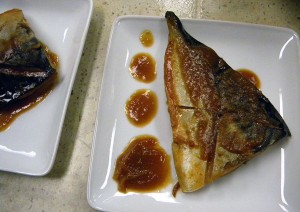
Japanese-style mackerel in miso
Although desserts are rarely served in Japan they are pretty popular in the west, and Hana had a surprise dessert for us: green tea ice cream sprinkled with the nutty flavoured roasted soy bean flour.
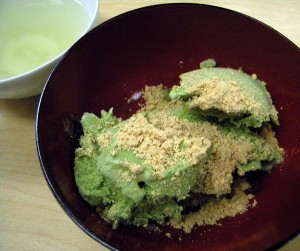
green tea ice cream with nutty roasted soy bean flour on top
Gallery of images from my Japanese Home-Cooking Class, offered by UBC Continuing Studies and taught by Hana Dethlefsen. Hana has her own blog with lots of Japanese recipes and restaurant reviews at: http://letsforking.wordpress.com/
-

-
green tea ice cream with nutty roasted soy bean flour on top
-
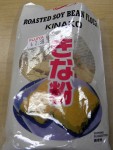
-
package of roasted soy bean flour with a pleasant nutty flavour
-
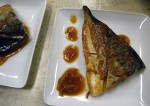
-
Japanese-style mackerel in miso
-

-
mackerel cooking in the miso
-

-
the mackerel were first scored with large Xs to allow the flavour of the miso to penetrate
-

-
ingredients for Japanese-style mackerel
-
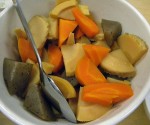
-
nimono: ‘things’ simmered in soup stock
-
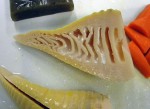
-
the bamboo shoot slice open to show the white grit in the ‘gills’
-

-
bamboo shoots, yam gelatin, carrots and other ingredients for the nimono, simmered vegetables
-
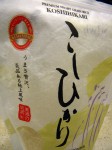
-
beautiful Japanese packaging of polished white rice (uruchi mai) This is the most common rice used in Japan, and is used both as a side dish and for sushi.
-

-
onion & jako salad
-
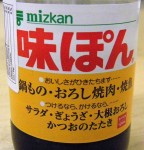
-
the label on a bottle of Ponzu, a Japanese dipping sauce
-
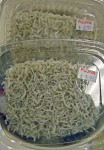
-
jako, tiny baby sardines
-
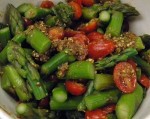
-
Japanese sesame-dressed salad aka ‘gomaae’
-
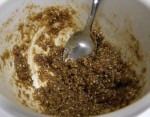
-
the sesame dressing for the gomaae salad
-
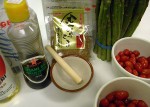
-
ingredients for the sesame-dressed salad known as Gomaae
-
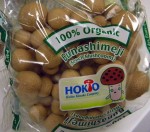
-
paquet of tiny beech mushrooms
-
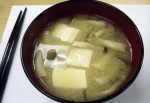
-
miso soup with tofu and beech mushrooms






